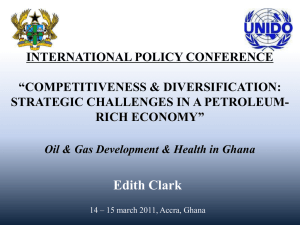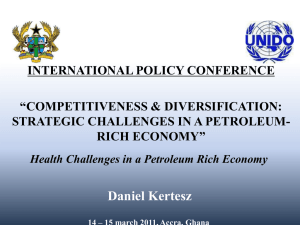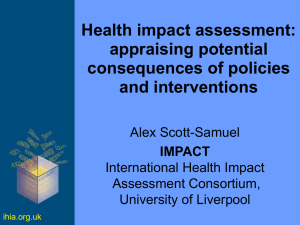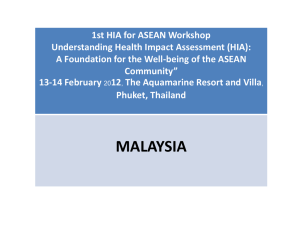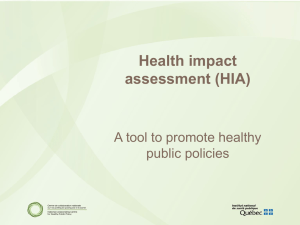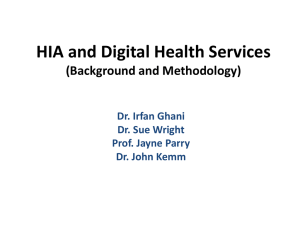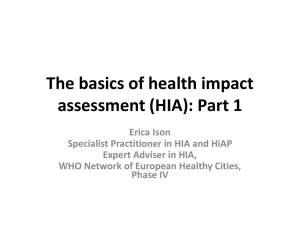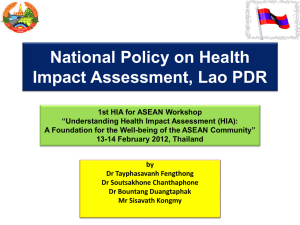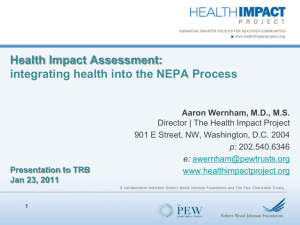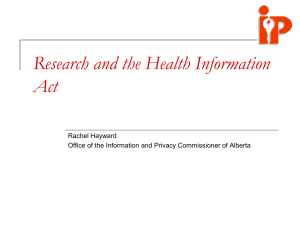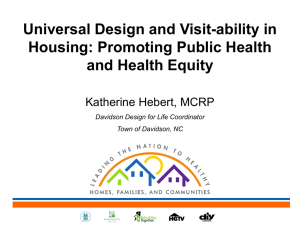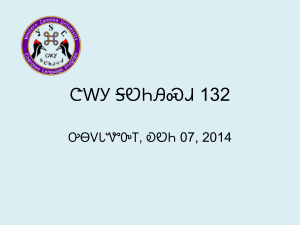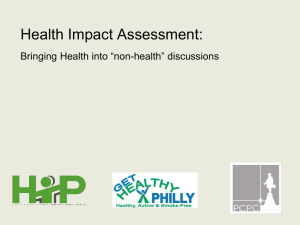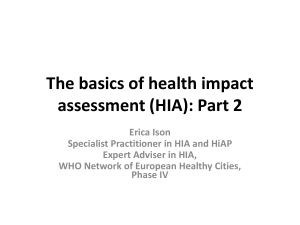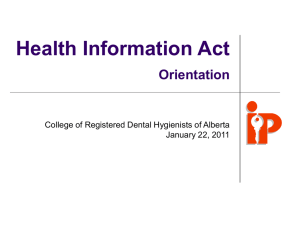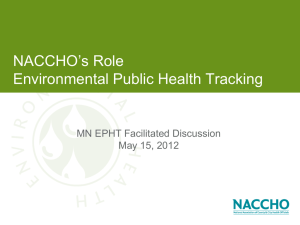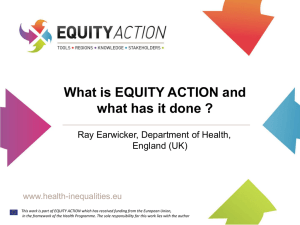document - The Pew Charitable Trusts
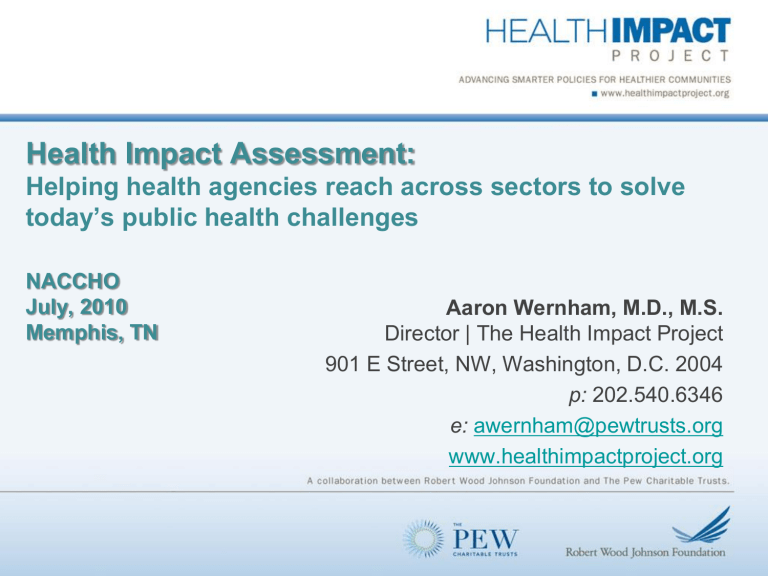
Health Impact Assessment:
Helping health agencies reach across sectors to solve today’s public health challenges
NACCHO
July, 2010
Memphis, TN
Aaron Wernham, M.D., M.S.
Director | The Health Impact Project
901 E Street, NW, Washington, D.C. 2004 p: 202.540.6346 e: awernham@pewtrusts.org
www.healthimpactproject.org
County Health
Rankings
RWJF and University of
Wisconsin Madison : www.countyhealthrankings.org/abo ut-project/background
Growing focus on nonhealth policies…
"(The) toxic combination of bad policies, economics, and politics is, in large measure, responsible for the fact that a majority of people in the world do not enjoy the good health that is biologically possible.”
WHO Commission on Social Determinants of Health, 2009
Growing focus on nonhealth policies, but…
No common language :
transportation engineers don’t understand health data.
public health professionals don’t understand the constraints and limitations of the planning process
Few formal requirements
No standard forums where health works with other sectors
No funding for new public health activities
“Going out on a limb:”
Public health is science-driven, and policy and planning are governed by many other considerations: economics, politics, technology, deadlines, etc …
Health Impact Assessment
A combination of procedures, methods and tools that systematically judges the potential effects of a policy, programme or project on the health of a population and the distribution of those effects within the population. HIA identifies appropriate actions to manage those effects.
(IAIA, 2006)
Bottom line: a staged process that makes judgments based on scientific data and public input, and develops solutions through close collaboration with the stakeholders and entity making the decision.
The HIA Process
1. Screening – is HIA feasible and likely to add value?
2. Scoping – determine the important health effects, affected populations, available evidence, etc
3. Assessment – analyze baseline conditions and likely health effects
4. Recommendations – develop health-based recs and a feasible plan for implementing them
5. Reporting – disseminate the report to the public, stakeholders, solicit input
6. Monitoring and Evaluation -- monitor results of HIA, monitor health outcomes; evaluate results of HIA
HIA as an iterative process
Assess
Monitor
Adaptive
Management
Manage impacts
Monitor
Adjust
Mgmt
Reassess
7
Analytical Framework
Proposed policy, project, program
Determinants of health
Health outcomes
• Broad framework: considers multiple determinants and dimensions of health
• Focuses on an active decision
• Considers direct, indirect, and cumulative pathways
• Both qualitative and quantitative methods used, as is expert opinion
Assessment in HIA
Looking at the evidence and using judgment
Social, economic, environmental impacts
Public input
Baseline conditions, health inequities
Literature
Review, modeling
Predicted Health
Effects
The Health Impact Project:
A collaboration of the Robert Wood Johnson
Foundation and The Pew Charitable Trusts
Overall Objective:
To promote and support the use of HIA as a tool to ensure that decisions in non-health sectors, whether at the local, state, tribal, or federal level, are made with health in mind.
Visit www.healthimpactproject.org
11
Thank you
Health Impact Assessment
International context
Canada: pioneered integrated HIA/EIA. Still intermittent practice, both within and outside EIA
Individual European nations:
• wide range of laws, practice
• broad applications in policy and land-use common
• variety of governance structures
Australia and New Zealand: very well developed practice, variety of government supports and some mandates. Practice includes
HIA/EIA and standalone HIA.
EU: mandated use of HIA for all EU policies
Thailand: strong HIA requirements; community control.
Ghana: establishing HIA program
12
Health Impact Assessment
Development lending and international business
World Bank and IFC: part of evaluation standards for large development loans
(IFC Guidance Note 4: http://www.ifc.org/ifcext/enviro.nsf/Content/GuidanceNotes )
Equator Principles: ratified by the majority of large lending banks worldwide,
Multinational Corporations: eg Shell,
Chevron, large mining companies:
13
Completed HIAs in the United States (2008)
1999 –2009 (N = 58)
WA 4
MT 1 MN 5
OR 2
CA
25
CO 2
MI 1
OH 1
PA 1
MA 2
MD 1
NJ 1
AK 6
TX 1
GA 4
FL
1
HIA Practice in the U.S.
Current numbers -- estimated
Completed HIAs: 85 (approx., likely higher)
HIAs in progress: 30 that we know about
• No mandates outside environmental impact assessment
• Despite mandates, little consideration of health in EIA
• Several laws introduced at local, state, federal level
Please let us know about your HIA work! http://www.healthimpactproject.org/hia_submit
26
Local Health Department HIAs
Sector/Topic
Land Use/Planning
• Redevelopment projects
• Comp plans, growth plans
• Transportation
Oil and Gas
Energy
Counties/Projects
SFDPH – dozens – many topics
Derby, CO – neighborhood redevelopment
Billings, MO; Humboldt, CA – growth plans;
Ingham, MI; Columbus, OH – sector plans
Decatur, GA -- transportation plan; Clark
County, WA -- highway; King County, WA – bridge; Multnomah County, OR – hwy/bridge
North Slope Borough, AK (in federal EIS)
Garfield County, CO
Green River tri-county, KY – coal-fired power plants
Proposals from 43 States
OK
ME
UT
HI WV
IN
SC KS
CT
MT
NE
NH
CA
CO
DC
ID
MD
MS
NM
WY
TX
NY
FL
MA
AR
AZ
MI
NJ
TN
VA
WA
WI
AK
IL
NC
KY
LA
OH
OR
MN
GA
MO PA
The Health Impact Project
220 proposals – 12 funded
1.Coal Gasification Plants: Green River Health Department will do an HIA of 3 proposed “clean coal” plants in KY
2.State Cap-and-Trade regulations: CA DPH -- HIA to inform rulemaking for California’s carbon cap and trade policy
3. Agriculture Policy: Kohala Center, a nonprofit in HI, will do an HIA to inform HI County’s A non-profit would engage in a county agricultural plan that will shape the local economy, land use patterns, and diet.
4.Wilshire Transportation Corridor, LA: LA DPH and UCLA will do an HIA of planned transportation corridor in LA
5.Farm to School Legislation: a non-profit in OR will do an HIA to inform deliberations on a farm to school bill.
The Health Impact Project CFP
Funded Projects
7. State Budget Process: New Hampshire Center for Public
Policy will address the NH budget
8. Transit Oriented Development: a. ISAIAH (a faith-based coalition) will use HIA to address planning decisions on a light-rail project in the Twin Cities.
b. TSU will use HIA to look at a proposal for TOD
9. Waste-fired power plant: Mass. Dept of Public Health will do an HIA of a proposed biomass power plant in an economically depressed area of Springfield, MA
10. Farm to School legislation: an OR non-profit public health group will undertake and HIA of proposed legislation to fund farm to school programs
19
The Health Impact Project:
Tools to help LHDs
Using existing regulations, policies, and standards that support the use of HIA?
• Review existing legal constructs that may support the inclusion of health – zoning laws, growth plans, regulatory impact analysis, etc.
Getting started: how to find the best opportunities for HIA?
• Cross-sector toolkit – finding the planning, policy, program and project-related decisions most likely to affect health; starting inter-agency collaborations
What makes HIA a good tool to address such a wide range of decision-making?
Is there more to it than just assessing impacts, making recommendations, and writing a report?
A new way to engage : brings public health professionals, community stakeholders, planners, developers, and decisionmakers to the table, with a focus on practical, realistic solutions.
• Address public concerns early and directly
• Ensure that public health input and recommendations are sensitive to the political, regulatory, and economic context.
